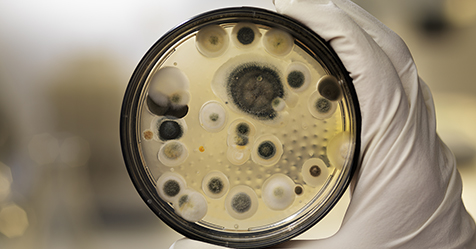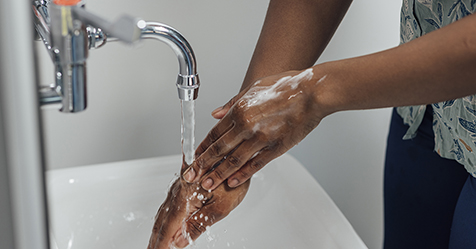- Wear protective gloves.
- Empty the receptacle contents by removing the liner bag, sealing it, and placing it in a lined cleaning cart trash receptacle or lined trash pickup container.
- Use extra caution when handling the liner, which may contain sharps, such as needles.
- Visually inspect the inside of the receptacle, cautiously remove debris remaining in the bottom, and discard it in the trash. Contact a supervisor immediately if you find evidence of sharps or a pool of liquid.
- Clean to remove any visible soiling of the inside and outside of the receptacle; only use paper towels or other disposable wipes.
- To properly disinfect, apply (via disposable wipes/spray bottle) an appropriate disinfectant to the interior and exterior of the receptacle, including to the lid, even when there is no visible soiling.
- Consult with your supplier to ensure you use an appropriate disinfectant.Appropriate disinfectants include a U.S. Environmental Protection Agency (EPA)-registered tuberculocides, sterilants registered by the EPA, products registered against HIV/HBV, or sterilants/high-level disinfectants cleared by the FDA.
- In order to be effective, follow the recommended dwell time on the manufacturer’s product label.
- To dry receptacle surfaces, only use paper towels or other disposable wipes, and discard them when saturated.
- To comply with the OSHA Bloodborne Pathogen Standard, line the clean receptacle with one bag that will completely cover the inside surface and totally enclose discarded sanitary products. This protects the janitorial staff from coming into direct contact with materials containing blood or body fluids.
- Check the dimension of the stall receptacle to choose the correct size bag. The liner should reach all the way around the sides and to the bottom of the receptacle.
- Use one liner bag only; do not place multiple paper bags in the receptacle.
- Carefully handle the filled trash disposal container; keep in mind that sharps and blood borne pathogens may be present. Do not sort through or compress trash, even with gloved hands.
- Inspect your work to ensure you meet visible and hygienic cleaning standards; ATP measurement can help to verify organic soil removal.
Many of the above tips on proper disinfection and handling of feminine waste receptacles were previously published by ISSA and Cleaning and Maintenance Management magazine.
Contributors to these guidelines include: Allen Rathey, president of the Healthy Facilities Institute; Lynn Krafft, building services contractor and International Custodial Advisors Network (ICAN) Ask the Experts (ATEX) editor; Perry Shimanoff, president of MC2, management and communication consultants; and Ann Germanow, founder and CEO of The Scensible Source Company, LLC.
For more tips on how to properly address and clean the women’s restroom, read “Tackling the Women’s Restrooms” from our 2015 Restroom Care Spotlight.
Posted On September 25, 2015


